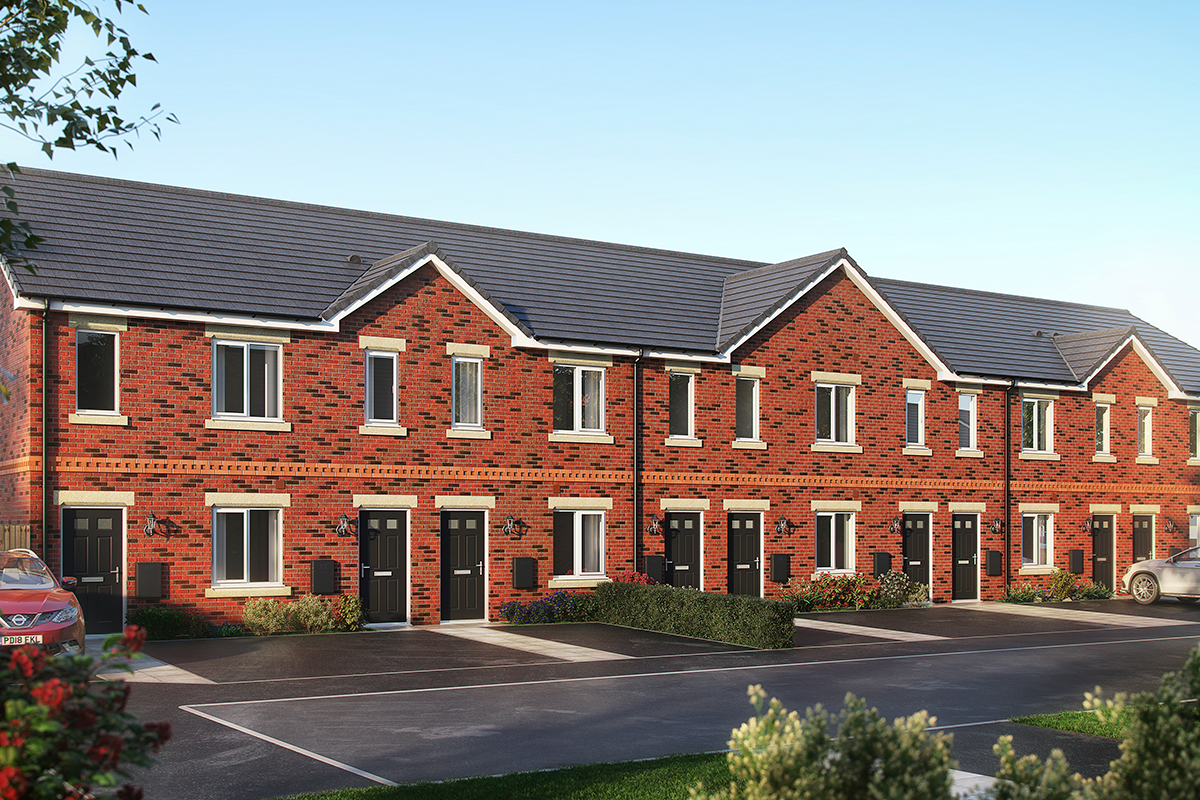You are viewing 1 of your 1 free articles
Market forces: the social landlords building homes for market rent
For most social landlords, market rent represents uncharted water. But as Alex Turner finds out, more and more are starting to dip their toes in
Nuvu’s Wavertree scheme, a 48-home development in Liverpool, which is being delivered by Your Housing Group
“We did some analysis and realised there was a grey area developing,” recalls Brian Cronin, chief executive of Your Housing Group (YHG), of his association’s decision to expand its interest in market rent development.
With most of its stock in Yorkshire, the Midlands and the North West, the organisation’s 28,000 homes do not intersect with England’s worst affordability hotspots.
Nonetheless, Mr Cronin says there was evidence many households who could previously have accessed the lower rungs of owner-occupation were instead finding themselves still renting flats as they started families.
“We came to a strategic decision that our remit was broadening to include couples who wouldn’t qualify for social housing, but whose options were often poorly managed or maintained private rented housing,” he explains.
Market rent housing remains a minority concern for social landlords. Completions have dropped slightly over the past three financial years according to National Housing Federation (NHF) data, from 4% to 3% of cross-tenure totals.
But the proportion of English households living in the private rented sector (PRS) has doubled from 10% to 20% over the past 20 years and now encompasses people of all age groups. Meanwhile, institutionalised build-to-rent is making inroads in the major cities. Unsurprisingly, some providers (and councils as well – see box) are looking to stake claims to pieces of this territory.
For YHG, this involved launching a distinct market rent brand, Nuvu, focused mostly on family homes. It has developments completed or under way at five locations in Warrington (see box), Stockport, Manchester and Liverpool.
Rents at the schemes, which amount to more than 300 homes, are significantly above Local Housing Allowance rates but well below the top of the market on Rightmove. Mr Cronin says around £700 a month is typical for a three-bedroom semi.
The aspiration is to give occupants a feeling of security similar to the association’s social housing tenants. That starts by offering default three-year tenancies.
“There are legal issues we’re working through,” he says, “but the idea is eventually to have one tenancy agreement and one standard across our stock, and offer all services in market rent to social homes and vice-versa.”
To achieve that consistency, YHG is reviewing whether its Nuvu branding should eventually be retired. With hindsight, Mr Cronin argues, doing so may make it simpler to set out to prospective tenants what a housing association can offer compared with the traditional PRS.
“There is a lot of worth in the [main YHG] brand – we’ve managed property for decades, look after residents, don’t easily evict people, and invest in our properties,” he says.
CGI of Nuvu’s Covent Garden flats in Stockport
For housing providers, of course, fostering stability also means a steady rental income stream as the value of their assets rise. YHG is aiming to build hundreds of market rent homes in the next five years, helping it to provide large, mixed-tenure schemes that will enable it to grow its footprint.
Should it succeed, it will join the limited ranks of housing associations doing market rent housing at scale. Inside Housing’s recent analysis of the 50 biggest housing association builders identified just five that completed 100 or more market rent homes during 2017/18.
One of these was A2 Dominion, which owns more than 37,000 homes across Southern England. The organisation had a legacy stock of around 400 market rent properties when it was formed in 2008 after a series of mergers.
“About 2012/13, money got tight as subsidy was cut, so we were looking at models to fund scale development, and those have been leasehold sale and private rent,” recalls Steve Michaux, director of residential services at A2 Dominion.
About 4% of the organisation’s homes are now market rent, Mr Michaux says, adding that the total of around 1,280 will grow by some 200 units a year, assuming A2 Dominion builds 1,000 annually across all tenures.
The council view
Local authorities have been getting into market rent housing through a range of vehicles.
In Manchester, Matrix Homes, a joint venture between the council and its pension fund, has delivered 240 homes, of which 120 are for rent, with a second phase of 340 to follow.
“We avoided anything too close to the city centre – we know the private rented sector works there, but we’re trying to prove the concept for low-rise homes, not apartment blocks,” explains Steve Sheen, housing strategy manager at the council.
Matrix’s rented stock, while above Local Housing Allowance rates, largely falls within Manchester Council’s locally defined guidelines for affordability. These set out that new homes in the city should be aligned to earnings, and not consume more than 30% of gross household incomes.
Housing association Places for People acts as a property manager for homes in the first Matrix phase via its Touchstone subsidiary – and will also build second-phase homes using one of its contractors.
In Birmingham, meanwhile, the council has developed more than 3,000 new homes for sale and social rent via its Birmingham Municipal Housing Trust.
This year, it has also got into market rent, setting up a wholly owned company, In-Reach, to provide build-to-rent apartments.
Its first scheme, Embankment, was tenanted earlier this year.
Embankment’s 92 apartments with balconies and high-speed broadband are pitched as ‘luxury’ and priced at £1,000 a month for a two-bed, with extended tenancies available.
“The target tenant was young professionals, but we also got downsizers and empty-nesters – even a couple of pensioners,” says Clive Skidmore, head of development at Birmingham Council. Income from the scheme and its successors will go into the authority’s general fund.
Like Mr Cronin, he says the key to market rent’s appeal is its reliable returns, as well as its inherent flexibility – homes can be converted to social or affordable rent based on demand or changes in the financial climate.
Here, he notes A2 Dominion has mostly developed market rent housing as part of mixed-tenure schemes.
But unlike YHG, 94% of A2 Dominion’s market rent housing is contained in city apartment blocks and is aimed primarily at households earning between £40,000 and £70,000 a year.
It is considering three-year tenancies, but turnover currently averages at just under two years. Consequently, the association has so far stuck with a standard 12-month assured shorthand tenancy.
Mr Michaux says tenants appreciate the service they get but being a housing association seems more an “extra tick box” than a prime motivation for choosing one of A2 Dominion’s homes.
The sector is still diversifying, argues Tim Weightman, major projects director at 67,000-home Places for People, which built 555 market rent homes in 2017/18 – the largest number on Inside Housing’s Top 50 Biggest Builders list. The experience of the association, which manages properties across England and Wales, shows there is no straightforward formula for delivering market rent housing, Mr Weightman adds.
Heaven rent?
Sam Bluck, in her Nuvu-branded home, with her husband and one of her children
“We never wanted to rent forever,” says 35-year-old Sam Bluck (pictured right), who moved into one of Your Housing Group’s Nuvu-branded market rent homes over the summer.
“For what you get here [though], there seem fewer pluses to buying – the house is lovely and [the housing association] seem on the ball if you come to them with any issues.”
Ms Bluck is a business administrator, and lives in the three-bedroom house in Warrington with her civil servant husband and two young children. The rent is £795 a month.
Previously, the family stayed with relatives to save money but Ms Bluck says they feel more secure in their new home than they would have if they had returned to the PRS. “We’ve signed a three-year tenancy and can do that again,” she says, adding that fees of £150 for moving in compared favourably to letting agents.
In east London, Kicky Rottink, 30, who rents a £1,600-a-month, two-bedroom apartment from A2 Dominion with her husband, says she didn’t set out to rent from a housing association but is glad she did. “We looked a couple of years ago at moving but were so disappointed by everything that we thought, ‘No, we’ll stay put,’” says Ms Rottink, an executive assistant, who has been in her home six years since moving from the Netherlands.
Ms Rottink initially rented her apartment furnished under an offer A2 Dominion extends to all London market rent tenants, but has since bought her own furniture. She says that while many tenants seem transient, she expects to be there a while longer.
“[The landlord has] always been helpful and I’ve heard lots of horror stories from friends,” she says.
“There’s this idea that when we talk about PRS that means ‘Generation Rent’ – people cut off from the housing ladder. But our customer base is diverse,” he says. “We have student sharers, families in houses and retired people.”
Places for People has around 2,700 market rent homes within its stock. But its property management subsidiary Touchstone looks after a further 22,000 PRS homes, while its fund management arm PfP Capital is involved in two separate schemes that will see hundreds of millions of pounds invested in ‘regular’ PRS and institutionalised build-to-rent units.
"The real evidence that bespoke private rented development could be an untapped resource for housing associations come when you look at the total numbers."
Behind Places for People, L&Q was the next largest builder of PRS homes in 2017/18, with 422 completions according to our figures. After that comes Thames Valley Housing (276 completions), A2 Dominion (226), and Notting Hill Genesis (159).
But the real evidence that bespoke private rented development could be an untapped resource for housing associations come when you look at the total numbers.
Only 13 associations listed any PRS completions whatsoever in 2017/18, and only seven managed 50 or more. The total number of new PRS homes across the sector came to just 11,865.
While he accepts that most associations will not want to have fingers in as many pies as Places for People, Mr Weightman nevertheless believes more can play an important role as markets develop over the coming years.
“We talk about PRS, but it isn’t yet a mature sector,” he says. “The idea is that it has to become more institutionalised, more professional and associated with ideas around longevity of tenancies, rather than rogue landlords looking to make a quick buck.”







